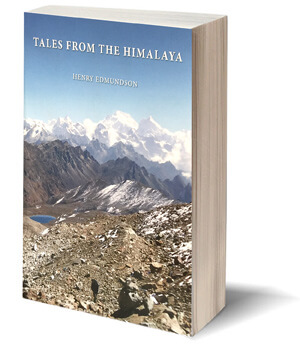A personal encyclopaedia of the Himalaya

If there is one book you must set aside, either for new year holiday reading or as a Christmas gift to a fellow traveller, it would be Tales from the Himalaya by the British climber-turned-trekker Henry Edmundson, which has just been published by Vajra Books.
Edmundson was a boy when news came to his home in England that Hillary and Tenzing had climbed Mt Everest. His father, an outdoorsy type, immediately took the family out on a celebratory hike over the hills. Soon, Edmundson was devouring books on mountaineering and exploration.
Read Also:
The Lumba Sumba Passage, Henry Edmundson
“It became a sort of obsession,” Edmundson said in Kathmandu this month after a trek to Lumba Sumba. His wife, and lifelong trekking partner Connie, piped in: “Not just ‘sort of’.”
By age 19, Edmundson was climbing in Kashmir and in Balistan in Pakistan, and in the past nearly 50 years he has trekked almost the entire Himalayan arc, from Afghanistan to Bhutan. The Kangchenjunga Base Camp-Lumba Sumba was one of the last missing bits before he did it this year.
The view from Lumba Sumba pass towards Kangchenjunga is the cover image of Tales from the Himalaya. The title may sound a bit prosaic for a personal encyclopaedia of the Himalaya spanning everything from the politics, geopolitics, geo-tectonics, geography, geology, cartography, history, adventure, culture and religion of these mountains. Vast in scope, and leaving out no details however slight, it is clear this is Edmundson’s life’s work.
Graduating in mathematical logic, he worked for an oil prospecting company to bring out a technical journal, and kept a meticulous diary of all his treks, fully intending to write a book about the experiences one day. “I wanted the book to be holistic because I believe in a non-specialist approach to make the subject interesting to non-experts,” Edmundson explains. “I try to make complicated things simple and not make simple things complicated.”
The book is divided into thematic chapters that are interwoven with his own personal travels across the Himalaya: Religion, Geology, Politics and Society — the last chapter dealing exclusively with Nepal’s political transition from war to peace, and up to the 2015 earthquake and Indian Blockade and their aftermath.
When he first arrived in Kathmandu in 1971 as a young lad, Edmundson had three letters of introduction from John Tyson, who was part of an unsuccessful attempt on Mt Api in 1953: one to the British Ambassador, another to trekking pioneer Col Jimmy Roberts and one to Swiss pilot Hardy Furer. That gave him all the access he needed to set off to the deep hinterland, with the help of legendary porter activist Mike Cheney.
For his first trek, the author’s team chose one of the most difficult ones they could find: to Kanjiroba and Dhorpatan. In that respect, Edmundson was doing the Great Himalayan Trail even before the concept was invented, confining himself not just to the Nepal Himalaya but to the entire 3,000km mountain arc. Along the way, he encountered more than just adventures in the wild: he found himself in the middle of a skirmish in Kashmir, in an earthquake in Nepal and witnessing the changes to trekking brought by new mountains roads and the climate crisis.
One useful thing about this book is that you do not need to read it cover to cover. Curled up on a cosy sofa by the fire, you can open up any section and start reading. There is a lucid account of Toni Hagen and his early geological exploration of Nepal, which leads directly into seismicity and the orogenesis of the 1934 and 2015 earthquakes. Backgrounds to more political upheavals in mountains are also all here, starting from the British Afghan campaign of 1847, the Chinese annexation of Tibet and the Sino-India War of 1962, right up to Nepal’s Maoist conflict.
Edmundson has put a huge amount of work into this book, in terms of research, gathering illustrations and maps, and the sheer exertion of undertaking trips across some of the most arduous terrain on Earth.
Maybe you do not need a more exciting title when the content is so stimulating. And, finally, we have a Western writer who does not pluralise the word ‘Himalaya’.

Tales from the Himalaya: Religion, Science, Politics, Society
by Henry Edmundson
Vajra Books, Kathmandu, 2019
424 pages, Rs4,800
ISBN 978-9937-9330-3-2
writer
Kunda Dixit is the former editor and publisher of Nepali Times. He is the author of 'Dateline Earth: Journalism As If the Planet Mattered' and 'A People War' trilogy of the Nepal conflict. He has a Masters in Journalism from Columbia University and is Visiting Faculty at New York University (Abu Dhabi Campus).




